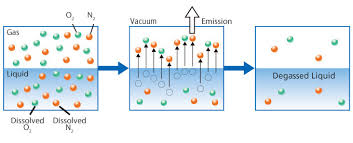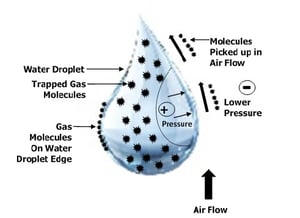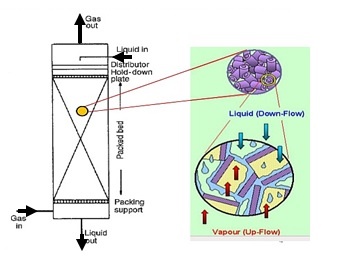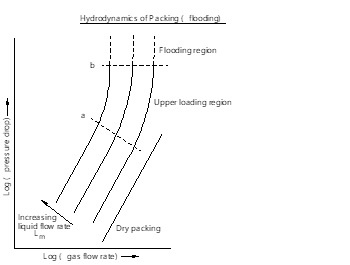In the production and purification of water for industry
there are many types of different processes available to remove harmful minerals and gases from the water stream but the most effective process and most cost-effective from both a capital investment and operational cost is a “Forced Draft Degasification System” (Degasifier).
Degasification is used in a wide range of water processes for industrial and municipal applications which extend from the production of chemicals to the production of semiconductors and in all applications the need to remove contaminants from the water and dissolved gases is key to achieving the end results needed in the industrial water process. Water from the ground often contains elements such as calcium carbonate, manganese, iron, salts, hydrogen sulfide, and sulfur just to name a few of the basic contaminants and these naturally occurring elements can cause serious damage and consequences to process equipment such as boiler systems, piping, membranes, and cation and anion exchange resins used in the demineralization process.
 Calcium carbonate can dissolve in water under certain pH ranges forming carbonic acid and releasing carbon dioxide (CO2) gases. These gases are not only very corrosive to equipment like boiler feed systems and boiler tubes but also attack the actual resin beds found in cation and anion softening and demineralization system causing an increase in regeneration and chemical consumption and resin bed replacement.
Calcium carbonate can dissolve in water under certain pH ranges forming carbonic acid and releasing carbon dioxide (CO2) gases. These gases are not only very corrosive to equipment like boiler feed systems and boiler tubes but also attack the actual resin beds found in cation and anion softening and demineralization system causing an increase in regeneration and chemical consumption and resin bed replacement.
By incorporating a Force Draft Degasification system you can remove dissolved gasses
like CO2 and hydrogen sulfide (H2S) to as low as 99.999% and improve the cation and anion system performance, extend the resin bed life, and lower the operating cost of the water treatment process.

Quite often Forced Draft Degasification is utilized “post” treatment to also remove newly formed dissolved gases prior to entering the boiler feed system to prevent corrosion damage within the tubes and feed system and pumps. These gases are easily removed with the forced draft degasifier at a much lower cost than chemical additives or liquid cell degasification that requires higher capital cost and much higher operating cost.
A Forced Draft Degasification system has lower capital cost, operates with far less energy and requires less maintenance than any other degasification process available.
A forced draft degasifier is the leader and choice for water purification in industrial applications like the semiconductor industry and chemical refining and is comprised of a vertically design tower constructed from either fiberglass, steel, stainless steel, or aluminum and contains a specified random or structured media packing, and distribution system, media support plate, sometimes wiper rings for redistribution, and a low pressure centrifugal blower operating at a range from 1-8 inches of water column pressure (WC). The media is selected based upon the type of contaminant, the other elements in the water, the temperature of the feed water, pH, LSI, and required removal efficiency. Water enters the forced draft degasification tower at the top and by gravity and specific weight of the water travels downward where it encounters a cross current airflow. As the water is constantly reshaped by the media Ntu values (Number of turn units) more and more molecules of dissolved gases are forced to the surface of the water where through the proportional pressure laws (Henry's Constant) the gases are stripped and released into the counter current airflow and then exhausted at the top of the degasification tower.

The forced draft degasification system requires a calculation and design to maximize removal efficiency and avoid costly design mistakes. Based upon the flow a hydraulic load calculation is performed in relationship to the mass gas transfer coefficient needed to achieve removal efficiency results. If the forced draft degasifier design is sized incorrectly and too small in can results in a condition called hydraulic flood. If it is calculated to large it can cause a condition called channeling. In both cases results will not be as desired and the impact can be the operating cost of your cation and anion resin, membrane system, or boiler equipment.

Companies like DeLoach Industries Inc. pioneered the development of Forced Draft Degasification treatment for municipal and industrial applications.
The company began in 1959 and played a major role in the development of reverse osmosis and degasification to preserve cation and anion systems and produce purified water for industries like the semiconductor market and others. For all of your needs in this area including the newly developed artificial intelligence water system DeLoach Industries offer full technical support and a 60 year lifetime of knowledge. For more information or to learn more contact the professionals at DeLoach Industries Inc. at (941) 371-4995.
Register to receive our forced draft degasification pre & post reverse osmosis webinar





